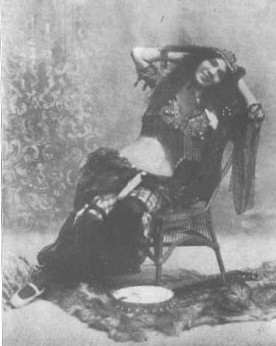
Comments by Bob Corbett
July 2004
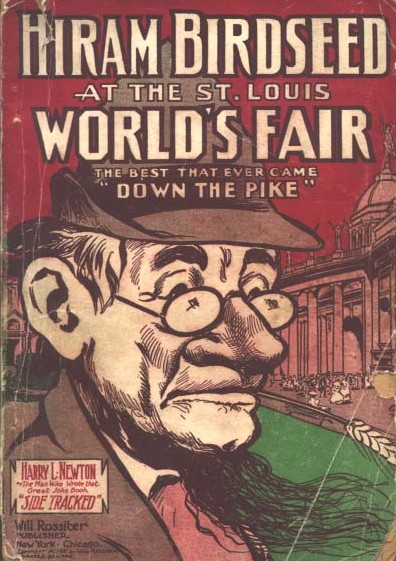
Hiram Birdseed, a country hick, is in the local general store back home in the country. He is telling the story of his trip to St. Louis for the World's Fair. The novel is corny and very old fashioned humor, told in heavy "hick" dialect, but it is at times also very funny.
The author was obviously at the fair and actually knows it and the city quite well, making me wonder if the Harry L. Newton might not even be a St. Louisan.
One of the things that Hiram makes more clear than most literature I have read on the fair is that the famous PIKE was separate from the fair, not included in the admission price nor regarded by the visitors as part of the fair. It was NEXT to it, on Lindell Blvd., outside the fair grounds and the center of pleasures, food, drink and more.
Since the humor is a bit old, I've decided not to include much of the text of the fictional part of the book. However, for those who want a sample, click here for the first chapter -- Hiram's trip to the Fair.
After the novel ends the author (a good friend of Hiram) then provides a lovely travel guide with many 33 photos, of the fair.
Below I present the text of the travel guide since it seems to me about the best, most detailed and "normal" report on travelling to the fair of anything I've read. I don't include all the photos, but a few. I think it is interesting to note that in both the novel and the non-fiction section the author is much more impressed with The Pike than with The Fair itself.
After reading the novel and the travel guide I rather suspect that view might well have been shared by many many of the visitors, locals and out of towners.
The following suggestions and hints may not prove amiss to the intended World's Fair visitor. They have been carefully compiled from close personal observations by Hiram Birdseed, are not supposed to be humorous, and will certainly prove of incalculable value to the reader, whom we rather imagine will be a "stranger in a strange land," and be deeply thankful for all the information he can obtain.
You have probably heard much about "high prices" in St. Louis and the Fair proper. It is doing both a great injustice for reports of that character to be circulated. The prices are not any higher in St. Louis than in any large city. Most of the hotels have the same scale of prices now that they did before the opening of the Fair. Some have, of course, raised their prices, but all the first-class hotels still maintain their former scale of rates.
The majority of people who circulate false reports regarding the cost of living in St. Louis, are generally people who board or live at their own home for $5 or $7 per week, and when they go to the Fair they return home and invent stories of how much money they spent and how high everything was. They wish to pose as "spenders" and people who just throw their money to the birds. In justice to the "Fair Town," we have given you this heart to heart talk. Of course, if one wishes, money may be spent like water, but, on the other hand, one may see all that's worth the seeing and do it very reasonably. With this idea in view we have arranged the following list of hotels, boarding-houses, etc.
A list of one thousand carefully selected, elegantly furnished rooms in private families, in the best part of the city, close to the Fair and on direct car lines, at rates from one dollar per day up, may be obtained from The St. Louis World's Fair Association Co., at the Terminal Hotel lobby, Union Station. Office directly in front of Tracks One and Two.
A good plan is to open a correspondence with some of the following proprietors of hotels and engage your room in advance. This will save you the trouble and inconvenience of hustling around when you arrive in the city.
Upon reaching St. Louis, any street-car will take you direct to the Fair or transfer you there, or to your hotel or room, whichever place you are going. The street-car service in St. Louis cannot be excelled in any city in the country. The conductors have instructions to answer all questions regarding the directing of strangers, and all you need to know is the name and location of your stopping-place, and the conductors will see that you are transferred direct.
Before you leave your hotel, see that you have plenty of small change; it will save you many minutes in changing bills at the grounds. You should also be supplied with a fifty-cent piece for yourself and each member of the party, as no tickets are sold at the gates, but instead you drop your half-dollar into a slot in the gate turnstile. If there are children in the party, see that you have a twenty-five-cent piece for each of them. Children are admitted at half price.
Places have been provided just outside the gates where change will be made for you, but you will do well not to depend on them, as it involves a long delay and you wilt be crowded into line in order to get change. Therefore, get your change before leaving your lodging.
Another important tip: Take notice of the signs above the different gates. The gates are marked "Adults," "Children," and "Passes." At the adult gate only grown people are admitted. Children are admitted at the gate thus marked, while those fortunate enough to possess passes must enter the gate thus marked.
Look for the sign above the gate, and do not try to enter the wrong one, and much confusion will be saved thereby.
If you are possessed of an economical turn of mind, you may buy, for fifteen cents, a nice box of lunch, just outside the grounds. When ready to partake of same, a cup of coffee may be bought at the little stands scattered about the grounds; if not coffee, then milk, lemonade, or other soft drinks. If you sigh for beer, there is plenty of it -- all kinds. If you wish for something more substantial than a small lunch, a list of restaurants is given on one of the following pages.
There are many benches for tired people scattered about the grounds, but if you tire easily, take a camp stool along and you can sit down whenever the spirit moves you.
By consulting the map in this book, you will be enabled to save time and many weary steps by going direct to the point of interest you wish to see.
An automobile bus-line is in operation within the grounds. Twenty-five cents will give you a forty-minute ride. The man in charge will point out all the places of interest and give the names of each. It is a most excellent method of obtaining a general view of all.
The "Roller Chairs" are another method of transportation, which is a Godsend to many who are troubled with tired feet and physical weakness. They are also engaged by others who are not tired or weak, as it is a great comfort to see much with no exertion. The guides are all well posted and polite, and do everything to make it pleasant for you. A continuous trip from one point of interest to another will cost about twenty-five cents. By all means take a "Roller Chair" and be comfortable-also fashionable.
Another pleasant trip may be had on the Intramural Railroad, where for ten cents a trip all about the entire grounds may be indulged in. The cars are handsome and comfortable, and you get a magnificent view of everything -- also a good run for your money. Try it.
The Observation Wheel (Ferris) is a good place from which to get a bird's-eye view of the Fair and surrounding country. A ride in the wheel will give you a better idea of the vastness and general aspect of it all than a two-day's walk.
Now, don't try to see it ALL in one day. It is simply impossible! But if your time is limited to one day, we suggest that you spend the greater part of the day "doing" the Fair proper. "Take in" the Pike in the evening or late in the afternoon, as that is the time when the crowds are there, the "barkers" are at their best, and the shows are given more frequently. Tips on the Pike may be found on another page.
By all means see the Sunken Gardens, Grand Basin, Terrace of States, Wireless Telegraphy Tower, Plaza of St. Louis, Agriculture Building, Floral Clock, From New York to the North Pole, the Boer War, and then, if you have any time left, take in the Transportation and Electricity Buildings -- after that, the Pike.
The Jefferson Guards are all clever chaps. They are there to give you any assistance you may require (except monetary). Free toilets for men and women may be found at the ends of all the different buildings.
Kodaks may be carried and pictures taken everywhere except in the Agriculture Building. The photographing rights to that building are strictly reserved by the official photographer.
Smoking is strictly prohibited in all buildings, but not outside them.
Lovers of music will find a treat in store for them, as some of the finest bands in the country have been engaged. Band stands will be found in the different plazas. No charge.
Take it easy. Keep cool. Keep your head. Don't get nervous. Read Hiram Birdseed when you get tired, and you will enjoy every minute of your sight-seeing.
The Pike is the greatest, grandest show that has ever been "pulled " on the American public. Take ail the side-shows of all the circuses you ever saw, put them on the Pike, and it would make only a small part of the present exhibit. Take all the most wonderful things you ever saw in all your life, place them also on the Pike, and they would only make another small part.
There is no pen that can describe the Pike, no pictures that can give you the least idea what it is. You must SEE IT! After you have seen it you have seen the world.
For every cent you spend on the Pike you get a dollar's worth of enjoyment. Some have called the Pike a "big humbug." Well, that's what we want, if it is. Barnum humbugged us Americans, and he was the greatest showman that ever lived. Gee, it's great to be humbugged! We saw the Pike from one end to the other, and if we were humbugged we want to go hack and do it some more.
To those who are pressed for time and do not want to spend what little they have in an aimless hunt for good things, we give herewith a list of the attractions considered by many the best; also a complete list of the attractions, so that you can "pay your money and take your choice." What appeals to one may not be liked by another.
If you desire to "take in" the entire Pike, which all do, begin your tour at the east end and continue through the Pike and then over the trail to the Mining Gulch, and thence north by east to the Model Street, thus landing at the original starting point.
The subjoined is a complete list of attractions. They are all unusually novel and amusing, also instructive. Many of them have never before been exhibited at any exposition.
Some faint idea of the vastness of this "Ten Million Dollar Side Show" may be gathered from a perusal of the following list of wonderful and odd things seen on the Pike. Don't be a "piker," but be a Piker and see it all. Don't let anybody beat you to it and tell you of something you have not seen when you get back home. It will make you wish you had been a better Piker. So do it all when you have the chance.
For the benefit of those that have the habit of eating two or three times a day, we give a list of all the restaurants on the Pike and about the grounds. The prices are all reasonable and service good. Meals and lunches can be had from twenty-five cents, up.
An ostrich farm with a drove of sixty birds averaging from 250 to 450 pounds is a World's Fair feature. The birds are from a Southern California ranch. At the ostrich farm everything pertaining to these ornithological giants is explained to the visitor: the characteristics of the birds, how the magnificent plumage is produced, how they raise their young, and many other interesting facts are shown.
The height of the sixty birds on the ostrich farm varies from ten to eleven feet. They are coming into plumage and already give evidence of the rare plumage that will develop rapidly from now on. The black birds are the males, the brown the females. Both produce the ostrich plume of commerce, but the male is the richer. Twenty-four plumes are grown under each wing every nine months. The average age of an ostrich is eighty years, and the bird reaches maturity at three years. A strange characteristic of the bird is that the female mates but once in a lifetime. Should her mate die, the mother bird remains unmated till death. The male ostrich is not so constant.
The ostrich produces thirty to thirty-six eggs a year. Hatching requires forty-two days. The eggs weigh three and one-half to four pounds, and one equals thirty-two hen's eggs. The male and female birds occupy the nest in turn, each covering the eggs for a period of twelve hours. The chicks, when hatched, are about the size of a spring chicken. After three days they are obliged to forage for themselves. The young grow on an average a foot a month for the first six months, the measurement being taken to the top of the head. Ostrich farmers use the incubator almost altogether, an average of forty to forty-five chicks out of fifty eggs being secured, while Nature's process produces only an average of twenty-five chicks to every fifty eggs.
The brain of an ostrich is the smallest of any creature, relative to its size. It can be placed in a teaspoon. The weapon of the ostrich is his foot. The force of a kick from one is equal to that of a horse or a mule.
"Black Demon" is the king of the ostrich farm. He is one of three ostriches broken to harness. He pulls a sixty-five-pound sulky a half mile in one minute and three seconds. The driver weighs one hundred and thirty-two pounds. "Black Demon" stands ten feet high and weighs these hundred and seventeen pounds
Photo of ostriches. Lots of them.
Photo of Baby Elephants in front of Hagenbeck's, on the Pike
Mr. Elephant shooting the chutes-wonderful! He winks the other eye and tells you through his trumpet that he originated that sport on the mud-slimed banks of the Ganges, long before it was a "new" thing in America.
The elephant toboggan slide is one of the most popular "stunts" in the jungle panorama of the Hagenbeck show on the Pike at St. Louis. Not only does the modern mastodon take the thrilling plunge with the zest of his human brother, but he has a gay time in the big pool at the bottom of the incline.
We have the diving horse, the plunging elks, and dogs jumping from great heights, but never until now the diving elephant. It is the most sensational of all these "animal acts." On the way down the slide, the elephant is only the gray blur of a swiftly moving ton of Asiatic flesh. He squats on his haunches like a true Norwegian ski-runner. The front legs are thrust forward and the trunk is used, pole fashion, to guide him in the descent. When he arrives at the pool something happens. A torpedo might throw a higher column of water, but the volume hurled aloft by the impact of this mighty body is enough to wet the biggest lawn in Cincinnati at one ducking. Spray outspreads the limits of the pool and cools the crowd of spectators. Then the inundation -- the pool rises like a miniature Nile and overflows its banks.
“Oh, why, he's swimming! Well, really, I never thought an elephant swam," interrupts the megaphone of the animal, which is now rising from the surface like a sea-serpent and making itself heard before a square inch of the body becomes visible. It is the elephant's innings. He is in the water and he has the trainers at a disadvantage so long as he can keep clear of the banks. It is a way he has in India, so he has brought it along with him to America.
The baby elephants which shoot the chutes at St. Louis, were brought over from Hindostan by Lorenz Hagenbeck, the youngest son of Carl Hagenbeck, the Animal King. Mr. Hagenbeck tells of some interesting traits noticed by him while in that country. They prove that the elephant is a wiser animal than we have even given him credit for being, after a circus acquaintance of many years.
Photo of The Animal Paradise
Where all kinds of gild beasts join together in perfect harrnony in their native jungle. A wonderful panorama where the Biblical parable of the lion and the lamb lying down together comes true for the first Lime. Attracting great crowds at Hagenbeck's on the Pike.
The herd under the charge of young Hagenbeck frequently made twenty-two miles in four hours on their journey from the interior to the coast. The Ganges was forded at a point where the stream was four miles wide. The elephants crossed the sacred river in one half-hour, resting half way on a sand bar near the middle of the current. Recess, after the long swim of two miles, lasted only ten minutes. On the neck of each full-grown elephant sat the mahout, or native driver. The ponderous beast was urged into the river by the toes of the mahout, who tickled the elephant behind the ears, where he is peculiarly sensitive. Most of the time during the swim nothing would be visible of the body but the trumpet, held high above the tide. Air was continually drawn down through the tube of flesh to keep the lungs inflated and prevent drowning.
Photo of: Main Entrance, Hagenbeck's, on the Pike
Mr. Hagenbeck was highly amused by antics of the baby elephants. They climbed on their mothers' backs when the stream became too deep for them, and in this manner were safely carried over the more treacherous parts of the swiftly moving stream. An idea of the force of the current against which the animals were making their way is suggested by Mr. Hagenbeck, who says that the herd landed on the opposite bank, nearly two miles below the point where they entered the river. Several streams were crossed in this way before the herd was loaded on the steamers at Bombay.
Shooting the chutes is done in India by the elephants when they assemble on the sloping mud banks of the rivers. The animals start into the water from the top of these slippery declivities, and with a snort they are off. They spend hours in the muddy water under the heat of an equatorial sun. The river banks, however, are not quite the grade of the artificial chutes, so that when the elephant baby stands for the first time at the head of the real thing, he hesitates. One push down the incline is reassuring. He learns that there is no intention to sacrifice him, and the moment he strikes the water all fear of subsequent plunges leaves his nimble brain. Thereafter he mounts the platform with astonishing alacrity and hardly waits for the persuading hand of the trainer. Holding the trunk above his head, like the submarine diver, he inhales the air and keeps out of reach of the keepers.

Giant Tortoise, 300 Years Old
The oldest living animal. Weight, 1700 pounds, measuring seven feet across the shell. Picture shows the box in which he was brought over from Hamburg, Germany. This enormous beast broke the box trying to get out, as also shown in picture.
Who was it said "Forewarned is forearmed"? Well, never mind, some one has said it, and our conscience is clear in the quotation, for it reminds us to suggest to our readers, who contemplate visiting the World's Fair, a little timely preparation will not be amiss before entering the Lane of Amusement called the Pike. It is not our desire to inspire fear, nor have we anything to say of this amusement highway excepting to recommend it in the highest terms, and to state further that a visit to the Fair is incomplete without a journey through the Pike; but imagine, if you can, sauntering along in company with your best girl, and have an absolute stranger accost you in deep, sonorous tones, bidding you "Go to H---!" At any rate, that is what you may expect, and hence this enlightenment. Nothing personal is intended, merely modern Pike methods of calling your attention to a modern Pike show. Anything that has ever been done before is not done on the Pike; anything that has never been done before is being done on the Pike. It's all new under the sun, and as we said before, "Sensatioral revelations are the vogue along the famous thoroughfare." Looking in the direction pointed to by the Pike orator, once known as “Midway Spieler," a building representing externally the sombre gates of Hades is seen, and should you grant his request and pass through the great stone-arched corridor, a remarkable metamorphosis of your mind and body will occur. A grewsome atmosphere you have suddenly stumbled into -- none else but the Cabinet of the Dead -- and in order to visit the spiritual world, you have got to die. Coffins are provided, a grave and solemn monk appears and warns you to "Abandon all hope and follow on." Powerless to do any other than obey this awful command, you follow into a subterranean elevator and rapidly descend to the realms of darkness, the First Circle of the Nine in Hell, through all of which you must pass before again seeing the light of day.
Photo of front of an exhibit.
Crosing Acheron, the River of Woe, in Charon's boat, to the Second Circle; visiting the Court of Minos, the Infernal Judge, who dispenses justice to the endless line of wicked spirits. Further in your progress partaking of the beautiful visions of the unhappy Faust under Mephisto's influence, witnessing the continual grind of torture mills in the Frozen Third Circle; crossing Stygian Lake into the City of Dis or Eternal Fire; viewing all about you various punishments of abandoned souls; ever and anon startled by the inexplainable appearance and disappearance of some frightened spirit in your midst, and finally arriving at the very center of Hades, the Throne Room and awful presence of his Satanic Majesty. Mingling with his courtiers, skeletons, and subordinate devils, a chilly sensation creeps over you. Simultaneously the bewildered senses are aware of a changing atmosphere, and an instant later a marvelous transformation is fully realized. Sulphuric gases no longer confuse the brain; instead, delicious odors pervade the air, rare and beautiful foliage confronts the vision, the beautiful Grove of Daphne surrounds you, and Daphne herself beckons you onward and upward through the gates of Paradise. Gorgeous spectacular illusion effects tell the history of the "Three Wise Men of the desert," the dimly discerned and far distant “Star of Bethlehem," ever increasing in brilliancy, and the final culmination, the Bursting of Celestial Dawn, intensified by the soft strains of sacred songs and a vision of ethereal bodies in graceful evolutions, make up a production of transcendent glories and send you back to earth to again take up its ways with ever-pleasant, though conflicting, memories of your experience “Hereafter."
Photo of the street of Constantinople on the Pike.

One of the many dancing girls on the Pike
The World's Fair at St. Louis differs from all its predecessors in that the largest number of strange people ever collectively assembled in the history of the world have been gathered within the thirteen hundred acres of the Fair's confines. Since the last World's Fair at Chicago our country has extended its boundaries thousands of miles, and thus an entirely new phase has been put upon what might be called our racial contour. The discovery of new peoples in the Pacific Ocean, whose country is now tributary to our flag, seems to have whetted our appetite for the closer study of the tribes who were within our original borders from the dawn of time. Among them none form a more curious or interesting group than the Mokis and Zunis from the Painted Desert of the Colorado, in Arizona and New Mexico. These perfect specimens of the human genus are the descendants of the Cliff-Dwellers, who have occupied the region from a time when the memory of man runneth not to the contrary. As their name indicates, they occupy the caverns in the cliffs of the Colorado River. All of them abide in well-regulated family groups hundreds of feet above the surrounding level. Slender ladders connect their various abodes, and in their native state they live a life of contentment and quiet, cultivating the arts of peace, in strange contrast to the existence they led when their ancestors had to defend themselves from the northern savage invaders of the lower river country which was first occupied by them. In the Cliff-Dwellers' Concession at the World's Fair are three hundred Mokis and Zunis sojourning in an immense rock built especially for them. This vast mass of cement towers hundreds of feet above the nearby thoroughfare. At home they annually dance the Snake Dance, a ceremonial which the United States Government has ordered scientific reports on. In this dance the Moki priests charm venomous snakes and holding them in their mouths implore Gitche Manitou, their deity, for rain. It is of record that the answer comes from the clouds in gentle showers and with unfailing regularity. Beyond the rock in which these Mokis and Zunis dwell at the World's Fair is a theater, in which they show their skill as dancers, necromancers, and miracle-workers. They are today the most highly civilized of North American Indians. Their children differ in appearance from the papooses of other native tribes, and are raised with the utmost gentleness. The men and women do not resemble the North American Indians of the mountains and the plains. They appear as a distinct race.
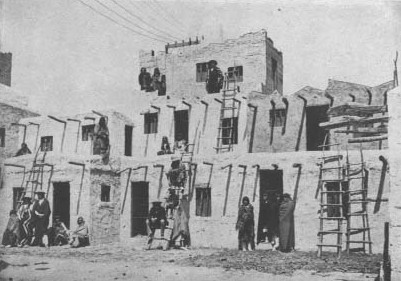
The Cliff-Dwellers
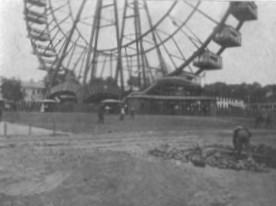
Lower part of Observation (Ferris) Wheel
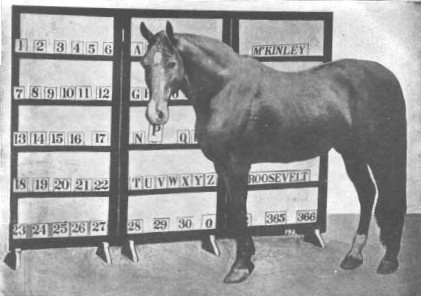
Beautiful Jim Key
Beautiful Jim Key, the educated horse at the Silver Horseshoe building on the Pike, has puzzled thousands of visitors to the Fair by his wonderful exhibitions of reasoning power. Jim Key can write his name on a blackboard, spell any ordinary word, do sums in addition, multiplication, subtraction and division, make change on a National cash register, file away documents, bring letters from the Post-office, and do about all that a boy of his own years, which are thirteen, can do. Jim Key is an Arabian-Hambletonian of the purest breed, and is as beautiful an animal as ever walked on four legs.
Photo of Group of Alaskan Esquimaux
One of the greathst novelties of the Pike Is the Esquimaux Village. Its towering iceberg front can be seen the entire length of the famous thoroughfare, and the many interesting features within the big concession give visitors much to think of and talk about. Two tribes of Esquimaux inhabit the Village. One comes from Alaska, and the other from Labrador, three thousand miles away. Their customs and manners are much alike, but their language is entirely different. The sports and pastimes of these strange people, as shown on the Village stage, cause great amusement, being quite dissimilar to those of any other uncivilized race. Their dexterity in throwing the harpoon in the pursuit of imaginary seals on the lake fronting the stage, is a never-ending cause of wonderment to the sightseer, and the ease with which they call handle a team of eight dogs on the mimic ice trail is something not readily forgotten. In connection with the Village is the Craine collection of arctic curios, said to be the largest and most complete of the kind In the world.
Photo of the building where this naval battle takes place.
The spectacle of half a thousand men, women, and children voluntarily boarding a boat they know is going to sink strikes us as sufficiently novel to chronicle in these columns. It happened on the Pike and in front of one of the mammoth structures on that highway. In the lobby of this building, known as “Under and Over the Sea" Concession, is a miniature harbor of real water. The exact depth of this little ocean we cannot positively say, but we can testify to what we saw with our own eyes on a recent visit to the World's Fair. In plain view of strollers on the Pike may be seen in this miniature harbor a submarine boat moored to a dock, with its hatchway open and passengers going aboard. The writer counted no less than five hundred reckless human beings seeking the sensations to be found in submarine navigation. When they were all aboard, the captain commanded the sailors on the dock to unfasten the ropes that held the vessel, and himself going below, the hatchway was closed and sealed hermetically, absolutely watertight. The boat then sank from sight in the great tank of water and a submarine journey to Paris has commenced. On reaching a certain great depth of the waters, indicated by one of the ship's instruments of measurement, the propellers were set in motion by a slight pressure of the electric button (the entire motive force employed in the queer craft used in the journey "Under and Over the Sea" is electrical. The huge steel hull trembled, the mighty engine throbbed, the powerful propellers churned the waters into a foaming fury and the boat darted forward through the transparent watery mass. Through plate-glass may be seen all manner of sea life. Arriving at Paris the passengers ascend the Effel Tower and make the return journey in an air-ship.
Photo of Entrance to "Creation"
Photo of One of the many beautiful pieces of statuary
Photo of The hot roast beef sandwich “barker”

Japanes Jinrikishas
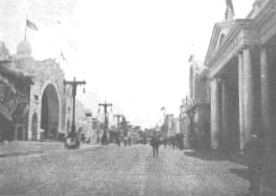
The Pike, looking east
14 other photos of various scenes and buildings at the Fair.
| HOME | DOGTOWN |
| Bibliography | Oral history | Recorded history | Photos |
| YOUR page | External links | Walking Tour |